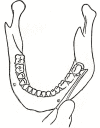Influence of two different surgical techniques on the difficulty of impacted lower third molar extraction and their post-operative complications
- PMID: 26116843
- PMCID: PMC4598936
- DOI: 10.4317/medoral.20605
Influence of two different surgical techniques on the difficulty of impacted lower third molar extraction and their post-operative complications
Abstract
Background: Post-operative complications of various degrees of severity are commonly observed in third molar impaction surgery. For this reason, a surgical procedure that decreases the trauma of bone and soft tissues should be a priority for surgeons. In the present study, we compare the efficacy and the post-operative complications of patients to whom two different surgical techniques were applied for impacted lower third molar extraction.
Material and methods: Patients of the first group underwent the classical bur technique, while patients of the second group underwent another technique, in which an elevator was placed on the buccal surface of the impacted molar in order to luxate the alveolar socket more easily.
Results: Comparing the two techniques, we observed a statistically significant decrease in the duration of the procedure and in the need for tooth sectioning when applying the second surgical technique, while the post-operative complications were similar in the two groups. We also found a statistically significant lower incidence of lingual nerve lesions and only a slightly higher frequency of sharp mandibular bone irregularities in the second group, which however was not statistically significant.
Conclusions: The results of our study indicate that the surgical technique using an elevator on the buccal surface of the tooth seems to be a reliable method to extract impacted third molars safely, easily, quickly and with the minimum trauma to the surrounding tissues.
Conflict of interest statement
Figures


References
-
- Rosa AL, Carneiro MG, Lavrador MA, Novaes AB. Influence of flap design on periodontal healing of second molars after extraction of impacted mandibular third molars. Oral Surg Oral Med Oral Pathol Oral Radiol Endod. 2002;93:404–7. - PubMed
-
- Farish SE, Bouloux GF. General technique of third molar removal. Oral Maxillofac Surg Clin North Am. 2007;19:23–43. - PubMed
-
- Cetinkaya BO, Sumer M, Tutkun F, Sandikci EO, Misir F. Influence of different suturing techniques on periodontal health of the adjacent second molars after extraction of impacted mandibular third molars. Oral Surg Oral Med Oral Pathol Oral Radiol Endod. 2009;108:156–61. - PubMed
Publication types
MeSH terms
LinkOut - more resources
Full Text Sources
Other Literature Sources

